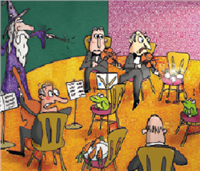Last year was the 20th anniversary of a controversial book The Maestro Myth, in which music critic Norman Lebrecht went to town on the business of the over-paid, over-sexed and never here international conductor. His thesis was that the era of the megalomaniac conductor waving his baton like Voldemort’s wand at an orchestra of powerless musicians was over. In many ways comparing a conductor to a wizard is not so silly – they both work with a stick, both have a power over others and both can create magic. (I wish sometimes I had a little of the Snape in me, because the ability to turn a recalcitrant loud mouth muso into a bowl of turnips during rehearsal would be a great skill.)

There is still a mystique about the role of the conductor. Many people ask me exactly what we do. I’ve asked myself that question many times, sometimes in the middle of a performance. Conductors only became necessary when orchestras got too big to operate as chamber ensembles. The conductor morphed from a time-keeping (let’s all start and end together) functionary into some sort of mystical creature...










Comments
Log in to join the conversation.